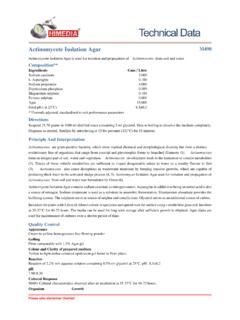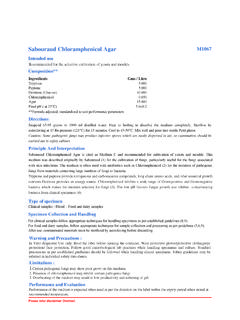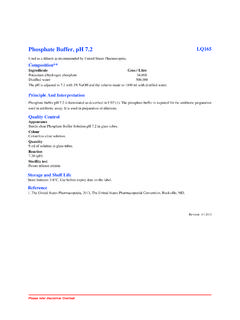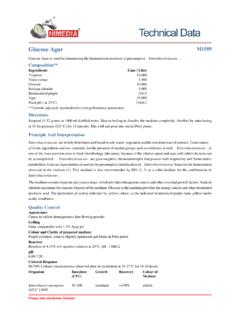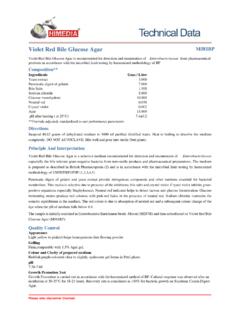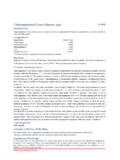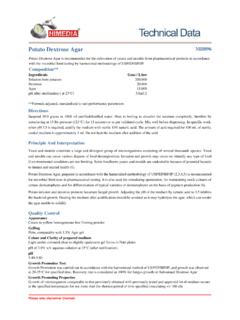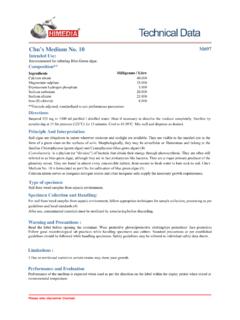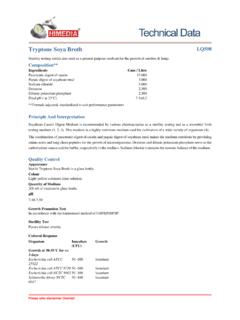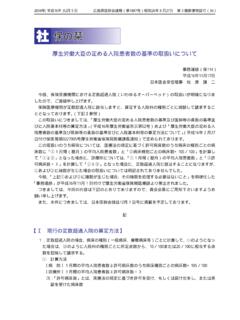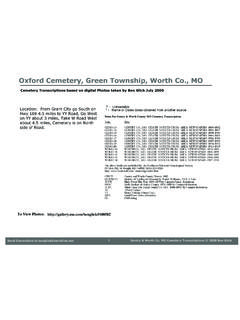Transcription of Alkaline Saline Peptone Water (ASPW) - HiMedia …
1 Please refer disclaimer **IngredientsGms / after sterilization ( at 25 C) **Formula adjusted, standardized to suit performance parametersDirectionsSuspend 40 grams in 1000 ml purified / distilled Water . Heat if necessary to dissolve the medium completely. Dispense in tubes or flasks as desired. Sterilize by autoclaving at 15 lbs pressure (121 C) for 15 minutes. Principle And InterpretationVibrio have played a significant role in human history. Outbreaks of cholera, caused by Vibrio cholera, can be traced back in time to early recorded descriptions of enteric infections. The Vibrios have also received the attention of marine microbiologists who observed that the readily cultured bacterial population in near-shore waters and those associated with fish and shell fish were predominantly Vibrio species (8).
2 Vibrio species are mainly responsible for causing cholera and food poisoning in humans. Vibrio cholera causes cholerae due to the intake of contaminated food such as raw oysters. Vibrio parahaemolyticus is a major cause of food borne infections, causing food poisoning (1). Since Vibrio species naturally occur in sea Water , worth special mention is their need for sodium chloride, although some species can grow with minimum sodium chloride concentration (8). The widely used media for Vibrio isolation are TCBS Agar and Alkaline Peptone Water (3). Alkaline Saline Peptone Water (ASPW) is in accordance with ISO/TS 21872-1:2017 which specifies a horizontal method for the detection of the two main pathogenic Vibrio species causing intestinal illness in humans: V.
3 Parahaemolyticus and (4). It is applicable to products intended for human consumption and the feeding of animals, and environmental samples in the area of food production and food handling. Peptone provides carbonaceous, nitrogeneous and essential nutrients to the organisms. High concentration of sodium chloride in addition to maintaining the osmotic equilibrium also has an inhibitory action on the accompanying Saline Peptone Water (ASPW)Intended Use:Recommended for enrichment of Vibrio species from food and Water samples in accordance with of specimen Clinical sample; Food samples; Water samplesFor clinical samples follow appropriate techniques for handling specimens as per established guidelines (5,6).For food and dairy samples, follow appropriate techniques for sample collection and processing as per guidelines (7).
4 For Water samples, follow appropriate techniques for sample collection, processing as per guidelines and local standards (2). After use, contaminated materials must be sterilized by autoclaving before discarding. Specimen Collection and Handling: Warning and PrecautionsIn Vitro diagnostic Use only. Read the label before opening the container. Wear protective gloves/protective clothing/eye protection/ face protection. Follow good microbiological lab practices while handling specimens and culture. Standard precautions as per established guidelines should be followed while handling clinical specimens. Safety guidelines may be referred in individual safety data strains of Vibrio species requiring higher sodium chloride concentration may show poor Further recovery from this enriched broth onto selective media is Biochemical characterization is carried out from pure isolates for complete LaboratoriesTechnical DataReferenceRevision : 03/2020 Quality ControlAppearanceCream to yellow homogeneous free flowing powderColour and Clarity of prepared mediumLight yellow coloured clear solution without any precipitateReactionReaction of 4% w/v aqueous solution at 25 C.
5 PH : ResponseCultural characteristics observed after an incubation at 35-37 C for 18-24 (CFU)GrowthVibrio cholerae ATCC1574850-100luxuriantVibrio parahaemolyticus ATCC 17802 (00037*)50-100luxuriant expiry period Performance and EvaluationPerformance of the medium is expected when used as per the direction on the label within thewhen stored at recommended : (*) Corresponding WDCM and Shelf LifeStore between 10-30 C in a tightly closed container and the prepared medium at 15-25 C. Use before expiry date on the label. On opening, product should be properly stored dry, after tightly capping the bottle in order to prevent lump formation due to the hygroscopic nature of the product. Improper storage of the product may lead to lump formation. Store in dry ventilated area protected from extremes of temperature and sources of ignition.
6 Seal the container tightly after use. Product performance is best if used within stated expiry period. User must ensure safe disposal by autoclaving and/or incineration of used or unusable preparations of this product. Follow established laboratory procedures in disposing of infectious materials and material that comes into contact with clinical sample must be decontaminated and disposed of in accordance with current laboratory techniques (5,6). Disposal1. Alcamo. , 2001. Fundamentals of Microbiology, 6th ed, Jones and Bartlett Publishers, Inc. pg 254, Baird , Eaton , and Rice , (Eds.), 2015, Standard Methods for the Examination of Water and Wastewater,23rd ed., APHA, Washington, Clesceri, Greenberg and Eaton (ed.). 1998. Standard Method for the examination of Water and Waste Water , 20th Public Health Association, Washington, D.
7 21872-1:2017. Horizontal method for the detection of the two main pathogenic Vibrio species causing intestinalillness in humans: V. parahaemolyticus and V. , Clinical Microbiology Procedures Handbook 2nd Jorgensen, , Pfaller, , Carroll, , Funke, G., Landry, , Richter, and Warnock., (2015) Manualof Clinical Microbiology, 11th Edition. Vol. Y., and Tortorello Fifth (Ed.), 2015, Compendium of Methods for the Microbiological Examination ofFoods, 5th Ed., American Public Health Association, Washington, Thompson et al (ed.). 2006. The Biology of Vibrios, ASM Press, chapter 1, pg refer disclaimer LaboratoriesTechnical DataIn vitro diagnostic medical device CE MarkingDo not use if package is damagedCE Partner 4U ,Esdoornlaan 13, 3951 DB Maarn The Netherlands, IVDS torage temperature10 C30 CEC REPHiMedia Laboratories Pvt.
8 Limited, 23 Vadhani Industrial Estate, LBS Marg,Mumbai-86,MS,India Disclaimer :User must ensure suitability of the product(s) in their application prior to use. Products conform solely to the information contained inthis and other related HiMedia publications. The information contained in this publication is based on our research and developmentwork and is to the best of our knowledge true and accurate. HiMedia Laboratories Pvt Ltd reserves the right to make changes tospecifications and information related to the products at any time. Products are not intended for human or animal or therapeutic use butfor laboratory,diagnostic, research or further manufacturing use only, unless otherwise specified. Statements contained herein should notbe considered as a warranty of any kind, expressed or implied, and no liability is accepted for infringement of any Laboratories Pvt.
9 Ltd. : 23, Vadhani , LBS Marg, Mumbai-400086, India. Customer care No.: 022-6116 9797 Corporate office : A-516,Swastik Disha Business Park,Via Vadhani Ind. Est., LBS Marg, Mumbai-400086, India. Customer care No.: 022-6147 1919 Email: Website.
